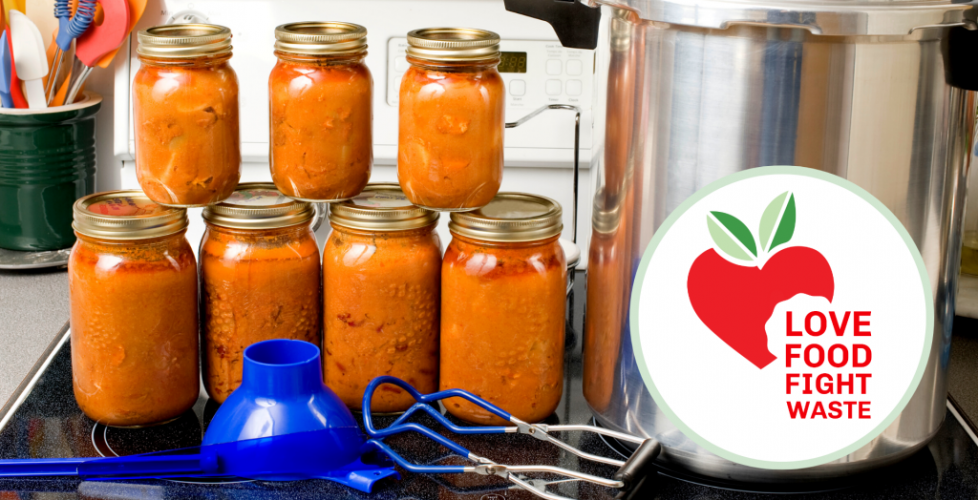Freeze & preserve your extra food
Winter is coming… but what are you going to do with all that zucchini that needs to be used now? Freezing and preserving your food will ensure you don’t have to throw extra away and you’ll get to enjoy that summer bounty throughout the long, cold winter months – it’s a win-win!
Monthly Topic Overview
You can save food for months – like hitting a “pause” button on it – by freezing or canning, and it just might surprise you how many different types of food can be preserved for long periods of time. Read on for tools to preserve your food safely while retaining as much delicious taste as possible.
Freezing 101
Here’s a few tips to keep in mind when preparing food to freeze:
- Keep food safety in mind. Don’t leave hot food out at room temperature for hours to cool off before freezing it, as this increases risk of foodborne illness. Instead, set the pan of just-cooked hot food in a tray of ice water so it cools down quickly before putting the food in the freezer.
- Package food in portion sizes before freezing. This makes it super easy to take out of the freezer and heat up for a quick meal later!
- Use airtight containers or bags to prevent freezer burn. (Note: freezer burn is harmless; it just makes food not as tasty.) Freezer bags, freezer wrap, aluminum foil, and freezer paper all work well as flexible, airtight containers to maximize your freezer space. Rigid containers work well for certain foods, especially liquids – just make sure you leave about a half-inch gap to allow for liquid expansion while it freezes.
- Label the food you’ve frozen with its contents and date. You can even try making a freezer inventory list. Generally it’s best to use foods within 8-12 months of freezing. Quality deteriorates over time, but as long as the food stays frozen, bacteria and molds don’t form.
When you get that food out of the freezer to use again, the safest ways to thaw it are to place it in the fridge (often overnight), heating it up in the microwave, or placing it in a bowl of cold water. If you use the microwave to thaw food, make sure you use it immediately afterward, since you don’t want it to sit at a temperature where bacteria can grow for long.
What foods can I freeze?
We’re serious: you can freeze almost anything to enjoy later! There’s a few foods that don’t freeze well (lettuce and cabbage become limp and watery, for example), but you may be surprised at just how much you can freeze.
- Flash-freeze fruits and veggies, like berries, or even bacon and bread slices so they don’t freeze in huge chunks. Flash-freezing is easy and fairly quick! Check out this video on how to flash-freeze.
- Frozen fruits (especially bananas) and even zucchini chunks make great smoothie ingredients.
- Freeze extra cheese and milk. Since these products don’t often last long in the fridge, freezing can be a great option to store leftovers if you don’t use these foods up quickly.
- Pro tip: use a muffin tin to freeze stews, chili, etc. in lunch-sized portions.
- Use an ice cube tray to freeze sauces, juices, and condiments. You can even freeze individual cracked eggs in cubes.
- Freeze chicken bones to make stock later.
- Try blanching veggies before freezing to slow vitamin loss and retain better quality.
Quick canning overview
Canning foods is another preservation option. Create jams, jellies, relishes, pickles, salsas, sauces, butters, and more by canning foods!
- Make sure you research how to safely home-can foods before you attempt this method to prevent risk of food-borne illness.
- There are a few different methods of canning foods, including boiling water bath, atmospheric steam canning, or pressure canning method. Research which method you should use for the type of food you are canning.
- This is a great source for more information on safely canning foods at home.
Activity
Learn more about the myriad of foods you can freeze and how to use those frozen foods in this article from the archives. Now do a quick sweep of your fridge and/or countertops. Is anything nearing the end of freshness? What can you transfer to the freezer? If you haven’t before, try some of the methods listed above or in the resources below to freeze your food to retain the most quality.
Other Resources
- Freezing Guide
- “Save the Food” Freezing Guide
- Canning resources
- Learn how to blanch different types of vegetables
Read more Love Food, Fight Waste topics, brought to you by Table to Table and the City of Iowa City.


